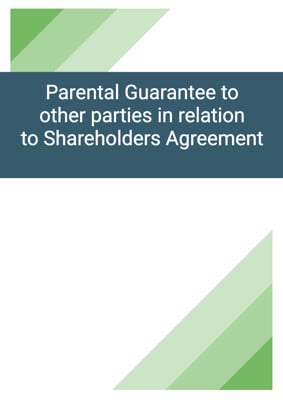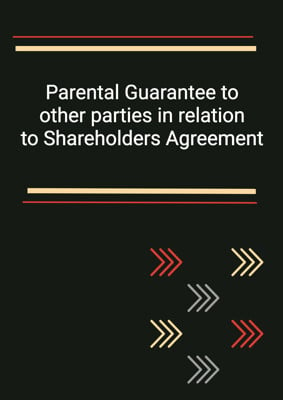How to Tailor the Document for Your Need?
01
Create Document
Fill in the details of the parties. You can click the "Fill with Member’s Information" button to complete it with information saved to your account.
02
Fill Information
Please fill in any additional information by following the step-by-step guide on the left hand side of the preview document and click the "Next" button.
03
Get Document
When you are done, click the "Get Document" button and you can download the document in Word or PDF format.
04
Review Document
Please get all parties to review the document carefully and make any final modifications to ensure that the details are correct before signing the document.
Document Preview
Document Description
The Shareholders Agreement is a legally binding document that outlines the terms and conditions governing the relationship between the shareholders of a company. It is entered into by Party 1, Party 2, Party 3, and Party 4, who have agreed to jointly invest in a company and set out the terms governing their relationship as shareholders. The agreement highlights the importance of the document in establishing the rights and obligations of the shareholders and ensuring the smooth operation of the company.
The document begins with an interpretation section, defining key terms used throughout the agreement. It provides definitions for accounting principles, directors, board, business, business day, business plan, chairman, chief executive, company, shareholders, shares, subsidiary, undertaking, and more.
The purpose of the company is described in detail, stating that the business of the company shall be conducted in the best interests of the company and in accordance with the general principles of the business plan approved by the parties.
The agreement outlines the characteristics of the company, including its name, registered office, authorized share capital, and initial directors, chairman, chief executive, and secretary.
It also covers capital and further finance, specifying the conditions under which the company's issued share capital may be increased and the funding support by the parties. The board and management section explains the responsibilities of the board, the composition of the board of directors, and the quorum for board meetings.
Reserved matters are defined as those matters that require the prior approval of the parties before any action or decision is taken. These include altering the memorandum and articles, changing the share capital, changing the nature of the business, transactions with a party's groups, approving changes in accounting policies, and winding-up proposals.
The agreement addresses financial matters such as accounting principles, auditors, and the company's financial year. It also covers information and reporting, confidentiality, non-competition, regulatory matters, relationship with party's group, tax matters, transfer of shares, termination events, default, and more.
The agreement concludes with provisions regarding parent company further assurances, non-assignment, waiver of rights, amendments, invalidity, no partnership or agency, announcements, costs, entire agreement, conflict with articles, notices, settlement of disputes, counterparts, and no rights for third parties.
This Shareholders Agreement is governed by the laws of the territory applicable therein, and any disputes arising from it shall be resolved through amicable settlement or through the exclusive jurisdiction of the courts of the territory.
How to use this document?
1. Review the definitions: Familiarize yourself with the definitions provided in the interpretation section of the agreement. This will help you understand the terms used throughout the document.
2. Understand the purpose of the company: Read the section that describes the purpose of the company and the general principles that should guide its business activities. This will give you an overview of the company's objectives.
3. Familiarize yourself with the characteristics of the company: Take note of the company's name, registered office, authorized share capital, and key personnel such as directors, chairman, chief executive, and secretary.
4. Understand the capital and further finance provisions: Review the section that explains how the company's share capital may be increased and the funding support provided by the parties. This will give you an understanding of the financial aspects of the agreement.
5. Learn about the board and management: Understand the responsibilities of the board, the composition of the board of directors, and the quorum for board meetings. This will help you understand the decision-making process within the company.
6. Familiarize yourself with the reserved matters: Take note of the matters that require the prior approval of the parties before any action or decision is taken. This will help you understand the areas where the parties have control and influence.
7. Review the financial matters: Understand the provisions related to accounting principles, auditors, and the company's financial year. This will give you an overview of the financial reporting and management aspects of the agreement.
8. Learn about information and reporting: Take note of the obligations regarding the provision of information and reporting between the parties. This will help you understand the communication requirements within the company.
9. Understand the confidentiality obligations: Review the provisions related to confidentiality and the protection of confidential information. This will help you understand the obligations regarding the handling of sensitive information.
10. Familiarize yourself with the non-competition provisions: Take note of the restrictions on competition with the company and the exceptions to those restrictions. This will help you understand the limitations on engaging in competing business activities.
11. Learn about regulatory matters: Understand the obligations regarding co-operation and the impact of regulatory actions on the agreement. This will help you understand the requirements for compliance with applicable laws and regulations.
12. Review the provisions related to the relationship with the party's group: Take note of the obligations regarding contracts with group companies and the promotion of the company's interests. This will help you understand the expectations for collaboration and support within the group.
13. Understand the provisions related to tax matters: Review the obligations regarding co-operation in relation to taxation and the making of returns, claims, or elections. This will help you understand the requirements for tax compliance.
14. Learn about the transfer of shares: Familiarize yourself with the provisions related to the transfer of shares, including the restrictions on transfer, permitted transfers, and the rights of the continuing party and affected party. This will help you understand the procedures for transferring ownership of shares.
15. Review the provisions related to termination events: Understand the circumstances that constitute termination events and the rights and obligations of the parties in such situations. This will help you understand the consequences of a termination event.
16. Learn about default and remedies: Familiarize yourself with the provisions related to default and the actions that can be taken in case of a breach of the agreement. This will help you understand the remedies available to the parties.
17. Review the transfer terms: Understand the terms and conditions that apply to the transfer of shares, including the obligations of the parties, the payment of consideration, and the completion process. This will help you understand the requirements for transferring ownership of shares.
18. Familiarize yourself with the parent company further assurances: Take note of the obligations to exercise voting rights and powers to ensure the fulfillment of the agreement. This will help you understand the expectations for active involvement and support from the parent company.
19. Understand the provisions related to amendments: Review the requirements for making amendments to the agreement and the conditions under which variations are valid. This will help you understand the process for modifying the terms of the agreement.
20. Learn about the notices and communication requirements: Familiarize yourself with the provisions related to notices and formal communications, including the methods of delivery and the addresses for service. This will help you understand the communication protocols between the parties.
21. Review the provisions related to the settlement of disputes: Understand the steps to be taken in case of a dispute and the options for resolving the matter amicably or through legal proceedings. This will help you understand the mechanisms for resolving conflicts.
22. Take note of the counterparts provision: Understand that the agreement may be executed in multiple counterparts, and each counterpart is considered an original. This will help you understand the flexibility in executing the agreement.
23. Remember that the agreement does not confer rights on third parties: Understand that the agreement is only enforceable by the parties involved and does not grant rights to any third parties. This will help you understand the limitations on the enforcement of the agreement.
Please note that this guidance is a summary and does not constitute legal advice. It is recommended to consult with a legal professional for a comprehensive understanding of the Shareholders Agreement and its implications.
Not the right document?
Don’t worry, we have thousands of documents for you to choose from:


























